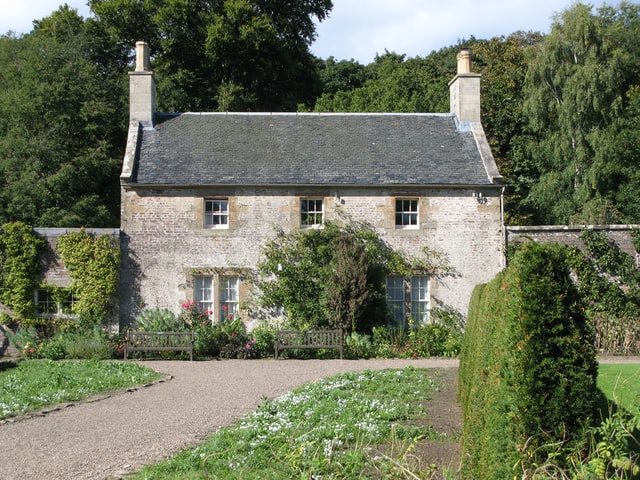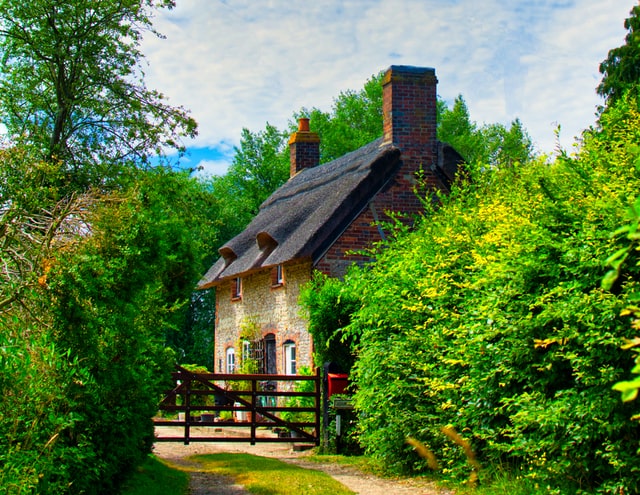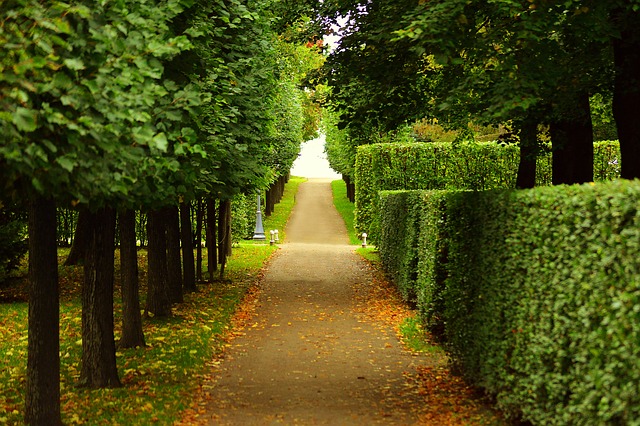Next up is the formative pruning of young hedges, to ensure that they are dense and bushy at the base to start with. The traditional approach is to cut back new or recently planted hedging plants, to prepare good foundations. Thinner, more straggly plants such as species of Crataegus, Prunus, Buxus and even Lonicera nitida all need pruning right from the start to encourage a good foundation. This means cutting back quite hard into the plant after planting, repeating this the next year. Other species, beech and hornbeam for example, should be cut back by up to one-third of the leader and side branches. Bushy conifers like yew, for example, need very little formative pruning.
In much of northern Europe, the practice is to plant much taller, thinner nursery stock than is common in Britain and to plant them far closer together. An example of this can be seen at Jacques Wirtz’s garden in Belgium, where tall, narrow hornbeam hedges create an elegant screen at the front of the house. I always enjoy coming across small differences like this between different cultures-books and education normally tend to toe the line, but something as common as hedging often becomes ingrained in our minds without much thought: plant small, cut back to make bushy. Yet across the Channel, in places closer to London than my own home, we see almost exactly the opposite, reminding me that there is still plenty of room left for the inquisitive gardener. In something as personal as one’s own garden, so many opportunities arise from keeping an open mind. I wonder what they do in Norway?
The Hedge As Architecture
So, rather than looking at how to grow a good hedge, which when it comes down to it, most people figure out for themselves without too much trouble, let’s look at how to make hedges more interesting-by using them as architecture and promoting them to a more assertive role in the garden. There are architectural features that are directly related to their stone and brick namesakes-buttresses, crenellations, windows, arches, niches, whole rooms even, but there are also pleached hedges, hedges on stilts, double and triple hedges, even mazes. Then there is design, and the use of the hedge not as a hedge at all, but as sculpture. And size. Very big, or wide hedges have a character all of their own. So whether your hedge is one of centuries-old yew, common privet, or even gloomy conifers, all sorts of things are possible.
Buttresses
When it comes to cathedrals, buttresses come in various shapes and sizes (remember flying buttresses?), but in the garden they are used not for structural reasons, but for visual impact. One normally comes across them in formal topiary gardens, appearing to prop up yew hedges. By breaking up the hedge, they make a series of bays that offer up all sorts of opportunities: if the hedge is at the back of a lawn, then benches and sculptures can fit snugly in the bays, framed by a buttress on either side. If it is at the back of a border, then the border can be planted up in themes; if in a kitchen garden, then vegetables can be planted in rotated beds.
They also make great places for games, and of course provide perfect firing positions and cover from imaginary enemy onslaughts. If, as has happened at Shakespeare’s New Place Museum in Stratford upon Avon, one neglects one’s buttresses and they turn from the imposing architectural things they were intended to be into great, swollen carbuncles, then they still serve similar purposes, with the added charm of a tumbledown country cottage, as if made of slowly decomposing hay bales rather than well-clipped yew.
Battlements And Crenellations
I imagine that most crenellated hedges are instigated by men, old men probably, for they are the logical progression from the sandcastles, camps and dens of childhood, for the young boy stuck inside the grown man. As with hedges in general, the character of the maker inevitably manifests itself in the results, so some crenellated hedges are tight and exact, while others are rather more shambolic, as if they have endured months of siege and heavy cannon fire.
The principles of crenellation construction are very simple. Once embarked on, it only takes a couple of years to turn some shaggy lumps at the top of the hedge into clearly defined fortifications. Ideally, the trunks of individual plants within the hedge should correspond with the merlons (the high bits) not the crenels (the low bits) as the growth of the trunks will be more vigorous-work with the hedge, not against it.
When it comes to clipping, unless you want your battlements to look like the Alamo, you need a bit of discipline to keep the tops of the merlons in line, the bottoms of the crenels flat, and the sides straight. Opting for the higgledy piggledy approach gives you more leeway for error, and the results can be just as effective.
Windows
Windows in hedges are great-something as simple as a hole can add humour, surprise, depth, symbolism and even poetry to a garden. Just as windows in walls let in light and frame views, so do hedge windows in walls let in light and frame views, so do hedge windows, but somehow, because it is not the sort of thing one normally sees in the garden, it injects an element of surprise too-and who can resist poking their head through a good hole in a hedge?
The best windows are not necessarily planned, but often materialize out of a patch of poorly growing hedge, suggesting themselves first as holes. They only become windows when properly framed, which is the tricky bit to do well, especially in wider hedges, where light has trouble reaching in. The basic principle is to cut part of the hedge’s foliage away with secateurs to reveal a rough window shape, taking care not to cut too much from the top of the hole, as the hedge will only regrow reluctantly from above. If need be, train down a thin branch to from the top frame. Start using shears or clippers to form dense frames, then clip as frequently as the rest of the hedge. Great fun could be had forming muntins from horizontal and vertical branches-and what is to stop them being glazed as well?
Arches
Nothing is more architectural in the garden than the arch. Used in the garden it takes the form of a gateway, an opening within a hedge. Extended into aqueducts, arches in the garden seem particularly popular in Germany-Schwetzingen Palace, for example, has a fine lime, or linden, aqueduct, echoing the real brick one that runs through the grounds. Essentially, this is a hedge with doors cut into it. It is flat along the top and each column is formed from one lime tree that is clipped close to the trunk for the vertical ascent, and allowed to connect on each side with the next tree. These arches seem as contrived as anything in the garden, even more so than much topiary, yet they fit in perfectly here, thanks to their architectural reference, their scale, and in the case of Schwetzingen Palace, their quality.




